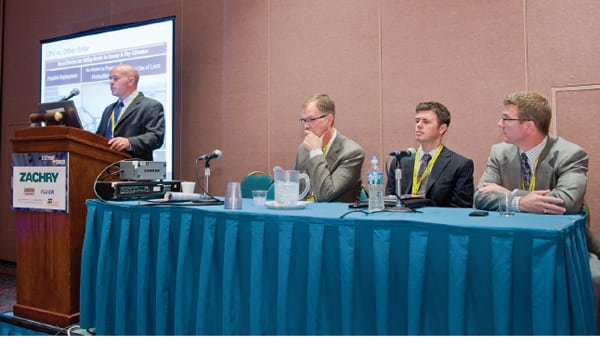Sunny Days Ahead for Solar
In the U.S., developers of thermal and photovoltaic solar plants face a number of challenges in their efforts to deploy more utility-scale solar power. Some trends, however, are helping solar proponents move this renewable energy source closer to becoming a mainstream generating option.
From new technical innovations to the latest business developments, panelists at the ELECTRIC POWER session on “Solar Power and Photovoltaics” offered a variety of perspectives about the new directions that this energy source is taking in the U.S. (Figure 1).
 |
| 1. Red-hot solar session. Members of the session panel were (left to right): E.L. “Mick” McDaniel, senior director of utility sales with Suntech America Inc.; Daniel Sampson, senior technical consultant with Worley Parsons; Brian Friend, technical director, Doosan Power Systems; and Brian Robertson, chief executive officer of Amonix Inc. Cochairs were Vas Choudhry, a California-based consulting engineer with many years of experience in the electric utility industry, and Angela Neville, JD, senior editor of POWER. Source: POWER |
Trends in Utility PV Plants
In his presentation, “PV in the Utility Generation Mix,” E.L. “Mick” McDaniel, senior director of utility sales with Suntech America Inc., focused on the growth of photovoltaic (PV) solar plants.
“Approximately 1.9 GW of large-scale PV solar projects are now under construction in North America,” he said. “Twelve plants larger than 50 MW have been completed within the last 12 months.”
Utility solar development is shifting to the U.S., according to McDaniel. Emphasizing the growing momentum of PV projects in North America, he pointed out that the largest PV plant in the world, a 92-MW facility, came online last year in Ontario. In addition, he said that construction is under way on 10 plants that each will generate more than 100 MW of electricity. Meanwhile, “the PV pipeline currently has over 22 GW of projects.”
McDaniel also pointed to statistics that show the U.S. PV market is experiencing strong growth. For example, in 2010, U.S. utilities had 242 MW of PV solar energy capacity. In contrast, by 2014, American utilities are projected to have approximately 2,508 MW of PV capacity.
McDaniel talked about the impact of market drivers on the U.S. solar sector. He first focused on policies that are having a positive effect on the growth of the solar market:
- State renewable portfolio standards
- Federal tax credits/cash grants
- State tax credits and/or renewable energy credit programs
Then he focused on the stimulative effects on the solar market from “cost progress” drivers:
- Declining system costs
- Declining development costs
- Increased speed of execution
- Lower cost of capital
Finally, McDaniel discussed how PV solar projects are moving along at a much faster rate than concentrated solar power (CSP, also known as thermal solar) projects. He provided the following current U.S. statistics:
- 538 PV solar projects and 518 CSP projects have been completed.
- 1,008 PV solar projects and 870 CSP projects are under construction.
- 21,000 PV solar projects and 8,060 CSP projects are under development.
Water System Design for Thermal Solar Plants
Daniel Sampson, senior technical consultant with Worley Parsons, emphasized the need to rethink the traditional water balance in thermal solar power plants in his paper, “Key Concepts in Thermal Solar Plant Water Systems Design.”
The operation and design of thermal solar power plants differs substantially from that of fossil fuel plants. The sun, rather than markets, determines the maximum possible plant dispatch, explained Sampson.
“Ideal plant locations seldom include abundant or readily available water,” he said. “The design of the power island is completely different from that of fossil plants, yet designers of thermal solar plant water systems often use the same principles and approaches common in their fossil plant cousins. This renewable technology requires fresh thinking in terms of water systems design.”
Unlike fossil plants, thermal solar plant operators can predict plant starts and stops to the minute. Water requirements, especially for the steam cycle, can be predicted with much more certainty than the water requirements of variable-dispatch fossil plants.
Predictability may improve, but unique challenges remain:
- Solar mirrors must be cleaned, so demineralized water usage increases.
- Permits often require complete or partial-zero-liquid discharge, but this complicated equipment requires a substantial commitment in capital and manpower.
- Plant water supplies may be of poor quality, limited availability, difficult accessibility, and high cost.
Water system design is always a balancing act, and that’s especially true for thermal solar plants. Their unique design and operating profile present both opportunities and challenges. Water quality and quantity must be evaluated carefully, and treatment processes must be designed around the unique thermal solar operating constraints. Simple designs are best, Sampson advised, because operating cost and operator involvement are usually lower with simple designs. That’s true of pretreatment, demineralization, and wastewater treatment systems.
New technology can provide benefits, but only after very careful consideration and risk mitigation. New approaches, nonetheless, must be used. In many cases, the tools don’t change, but they’re used differently and for different purposes. â–
— Angela Neville, JD, is POWER’s senior editor.